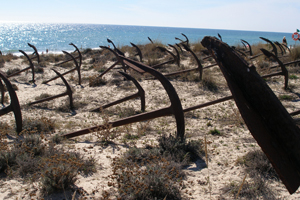
The East Algarve enjoys a remarkable climate, with sunshine throughout the year, mild winters and summers that are not too hot. It is much less developed than the rest of the Algarve, mainly due to the presence of the Ria Formosa Lagoon. This is a system of barrier islands with limited access from the land side that stretches all the way from Faro to Altura. In most places you will need to take a boat across to the sand bar, which can be a bit inconvenient but well worth the effort to reach the pristine beaches and clear waters beyond.
The Ria Formosa is a designated Natural Park, covering more than 170 km² and is a favourite place for bird watching since it is a major stopping place for hundreds of different migratory birds during the spring and autumn.
Heading east from Faro, along the old and slightly chaotic N125, the first town you reach is the fishing port of Olhao, with its historic fish market down by the water front. Heading East and slightly inland you come to the quiet, historic town of Estoi, famous for its pink palace and Roman Ruins, followed by the old cork capital, Sao Bras de Alportel and the rural village of Moncarapacho.

On the way to Tavira, you will come across the renowned beach at Barril, with its spectacular “anchor graveyard”, a picture postcard site the like of which you will probably never see anywhere else in the world. The next water-side village is Luz da Tavira, noted for its reputation as the “Octopus Capital of the World”
Then we reach Tavira, the jewel of the Algarve and the best-kept secret of Portugal. This charming and unspoiled town with its narrow cobbled streets straddles both banks of the River Gilao. It is famed for its Castle and 26 Churches, not to mention its many lively bars and restaurants.
Further east along the N125 you will pass by the delightful beach-side towns of Cabanas de Tavira, Cacela Velha and Altura before you eventually reach the East Algarve’s only real tourist resort, Monte Gordo. No longer part of the Ria Formosa reserve, this coastal resort boasts one or two beautiful beaches but with the easy access comes high-rise apartments and Spanish day-trippers attracted by the cheaper prices on this side of the border.
Finally, at the end of the N125 we arrive in the town of Vila Real de Santo Antonio, on the western banks for the Guadiana River which separates Portugal from Spain. Totally destroyed by the earthquake of 1755, it is reputed to be the town where the famed Algarve “calcada” cobbles originated.
But for the best suggestions for Things to Do in the Algarve, we suggest you check the Get Your Guide website.